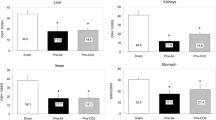Abstract
Background
This study aimed to investigate the time course changes in liver histology during carbon dioxide (CO2) pneumoperitoneum in a large animal model.
Methods
For this study, 14 white pigs were anesthetized. Liver biopsies performed 0, 1, and 2 h after establishment of CO2 pneumoperitoneum (at 12 mmHg) and after peritoneal desufflation were sent for histologic examination. Heart rate, mean blood pressure, hepatic artery flow, portal vein flow, and aortic flow were recorded in 10-min increments. Three animals served as control subjects.
Results
A statistically significant time course increase was observed in portal inflammation, intralobular inflammation, edema, sinusoidal dilation, sinusoidal hyperemia, centrilobular dilation, centrilobular hyperemia, pericentrilobular ischemia, and focal lytic necrosis scores. There were no significant changes in the control group. This eliminated an effect of anesthesia only. The portal vein flow increased as much as 21%, and the hepatic artery flow decreased as much as 31% of baseline, but these differences did not attain statistical significance. Aortic flow remained relatively stable.
Conclusion
Histomorphologic changes occurred, indicating liver tissue injury during CO2 pneumoperitoneum at an intraabdominal pressure of 12 mmHg in the porcine model. Portal vein flow increased, and hepatic artery flow decreased, whereas aortic flow remained relatively unaffected in this experiment.
Similar content being viewed by others
References
Agusti M, Elizalde J, Adalia R, Martinez-Palli G, Garcia-Valdecasas J, Pique J, Taura P (2001) The effects of vasoactive drugs on hepatic blood flow changes induced by CO2 laparoscopy: an animal study. Anesth Analg 93:1121–1126
Ali N, Eubanks W, Stamler J, Gow A, Lagoo-Deenadayalan S, Villegas L, El-Moalem H, Reynolds J (2005) A method to attenuate pneumoperitoneum-induced reductions in splanchnic blood flow. Ann Surg 241:256–261
Andrei V, Schein M, Margolis M, Rucinski J, Wise L (1998) Liver enzymes are commonly elevated following laparoscopic cholecystectomy: is elevated intraabdominal pressure the cause? Dig Surg 15:256–259
Eleftheriadis E, Kotzampassi K, Botsios D, Tzartinoglou E, Farmakis H, Dadoukis J (1996) Splanchnic ischemia during laparoscopic cholecystectomy. Surg Endosc 10:324–326
Gutt C, Oniu T, Mehrabi A, Schemmer P, Kashfi A, Kraus T, Buchler M (2004) Circulatory and respiratory complications of carbon dioxide insufflation. Dig Surg 21:95–105
Gutt C, Schmandra T (1999) Portal venous flow during CO2 pneumoperitoneum in the rat. Surg Endosc 13:902–905
Izumi K, Ishikawa K, Shiroshita H, Matsui Y, Shiraishi N, Kitano S (2005) Morphological changes in hepatic vascular endothelium after carbon dioxide pneumoperitoneum in a murine model. Surg Endosc 19:554–558
Jakimowicz J, Stultiens G, Smulders F (1998) Laparoscopic insufflation of the abdomen reduces portal venous flow. Surg Endosc 12:129–132
Junghans T, Bohm B, Grundel K, Schwenk W, Muller J (1997) Does pneumoperitoneum with different gases, body positions, and intraperitoneal pressures influence renal and hepatic blood flow? Surgery 121:206–211
Klopfenstein C, Morel D, Clergue F, Pastor C (1998) Effects of abdominal CO2 insufflation and changes of position on hepatic blood flow in anesthetized pigs. Am J Physiol 275:H900–H905
Kotake Y, Takeda J, Matsumoto M, Tagawa M, Kikuchi H (2001) Subclinical hepatic dysfunction in laparoscopic cholecystectomy and laparoscopic colectomy. Br J Anaesth 87:774–777
Lautt W (1985) Mechanism and role of intrinsic regulation of hepatic arterial blood flow: hepatic arterial buffer response. Am J Physiol 249:G549–G556
Rasmussen I, Berggren U, Arvidsson D, Ljungdahl M, Haglund U (1995) Effects of pneumoperitoneum on splanchnic hemodynamics: an experimental study in pigs. Eur J Surg 161:819–826
Richter S, Olinger A, Hildebrandt U, Menger M, Vollmar B (2001) Loss of physiologic hepatic blood flow control (“hepatic arterial buffer response”) during CO2 pneumoperitoneum in the rat. Anesth Analg 93:872–877
Saber A, Laraja R, Nalbandian H, Pablos-Mendez A, Hanna K (2000) Changes in liver function tests after laparoscopic cholecystectomy: not so rare, not always ominous. Am Surg 66:699–702
Schachtrupp A, Toens C, Hoer J, Klosterhalfen B, Lawong A, Schumpelick V (2002) A 24-h pneumoperitoneum leads to multiple organ impairment in a porcrine model. J Surg Res 106:37–45
Schafer M, Sagesser H, Reichen J, Krahenbuhl L (2001) Alterations in hemodynamics and hepatic and splanchnic circulation during laparoscopy in rats. Surg Endosc 15:1197–1201
Schilling M, Redaelli C, Krahenbuhl L, Signer C, Buchler M (1997) Splachnic microcirculatory changes during CO2 laparoscopy. J Am Coll Surg 184:378–382
Tan M, Xu F, Peng J, Li D, Chen L, Lv B, Zhao Z, Huang C, Zheng C (2003) Changes in the level of serum liver enzymes after laparoscopic surgery. World J Gastroenterol 9:364–367
Tuech J, Pessaux P, Regenet N, Rouge C, Bergamaschi R, Arnaud J (2002) Laparoscopic cholecystectomy in cirrhotic patients. Surg Laparosc Endosc Percutan Tech 12:227–231
Windberger U, Auer R, Keplinger F, Langle F, Heinze G, Schindl M, Losert U (1999) The role of intraabdominal pressure on splanchnic and pulmonary hemodynamic and metabolic changes during carbon dioxide pneumoperitoneum. Gastrointest Endosc 49:84–91
Yokoyama Y, Alterman D, Sarmadi A, Baveja R, Zhang J, Huynh T, Clemens M (2002) Hepatic vascular response to elevated intraperitoneal pressure in the rat. J Surg Res 105:86–94
Author information
Authors and Affiliations
Corresponding author
Additional information
Presented in part orally at the 10th World Congress of Endoscopic Surgery, Berlin, September 2006
Rights and permissions
About this article
Cite this article
Alexakis, N., Gakiopoulou, H., Dimitriou, C. et al. Liver histology alterations during carbon dioxide pneumoperitoneum in a porcine model. Surg Endosc 22, 415–420 (2008). https://doi.org/10.1007/s00464-007-9440-4
Published:
Issue Date:
DOI: https://doi.org/10.1007/s00464-007-9440-4




